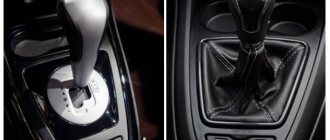"Lada Vesta" with CVT
The AMT robotic gearbox has received a lot of criticism from car owners and experts. During operation, weaknesses of the transmission were revealed. The situation changed at the end of 2022, when AvtoVAZ dealers received the first Vestas with a CVT. Lada Vesta with CVT is designated AT.
The Vesta CVT received a new engine developed by the Nissan concern. The power unit, adapted for installation on a domestic model, began to be produced at AvtoVAZ. The car received additional dynamics and comfort during operation.
Variability
I haven't forgotten! Renault also has the ancient “gluttonous” 4-speed automatic DP2 - but don’t put it on Vesta! Therefore, she was given the Jatco JF015E variator, known from Captur, Logan and Sandero in the Stepway City version, as well as from some Nissan models. The assortment is large, and if Ladas with a CVT sell well, it is possible that they will begin to be assembled in Russia.
The variator contains six virtual gears. Its main feature is a two-stage planetary gearbox, which protects the multilayer metal belt from excessive loads in unpleasant conditions. That is, the car starts off as if in a mechanical first gear - and only then the traction is picked up by the belt, and the transition process is provided by the torque converter. The same thing happens when driving in reverse gear.
It seems that it was the torque converter that gave marketers the idea of promoting the new transmission under the abbreviation AT - a type of classic automatic transmission. But let's not lie: this is a CVT.
When introducing a CVT on Logan and Sandero, engineers were unable to maintain the ground clearance of cars with manual transmission - due to the lower crankcase, the clearance was reduced by 20 mm. Therefore, CVT is installed only on “elevated” Stepways.
Vesta's ground clearance has not decreased. The variator, as on the Renault, is located lower: according to official data, in the sedan and station wagon - by 7 mm, and in the cross-country versions - by 4 mm. But the lower point of engine protection has not changed - the CVT Vesta has retained its outstanding geometric cross-country ability.
The Jatco JF015E is far from ideal; there have been a lot of complaints about its reliability. However, even before installing it on Lada, Nissan said that all the problems had been solved. If so, it must nurse its 150,000–200,000 km before the first investment, and this is not bad, although a hydromechanical automatic is still more reliable and hassle-free. VAZ people say that the oil in the variator does not need to be changed. We have a different opinion: the oil should be changed every 60,000 km if you want to live with a working CVT for a long time.
The warranty for Vesta CVT is the same as for other modifications: three years or 100,000 km.
When AvtoVAZ models received a variator
For the first time, a CVT transmission was installed on the X-RAY Cross. The updated crossover began to be sold at AvtoVAZ dealers in the summer of 2022. The Lada Vesta CVT model became available in November 2019. From that moment on, it became possible to purchase a Vesta SW Cross with a CVT.
"Vesta" with a variator. Photo source: https://xn--80aal0a.xn--80asehdb/auto-news/lada-vesta-news/5183-kakie-obnovlenija-poluchila-lada-vesta-s-variatorom.html
The AvtoVAZ model has become a worthy competitor to foreign cars. The improved transmission brought Vesta to the top of sales among domestic cars in the 1st quarter of 2022. A restyling is planned this year, which will bring many improvements in the appearance and interior of the car.
Engine on "Vesta" AT
The engine developed by the Renault-Nissan concern HR16DE-H4M has been installed on Vesta since 2015. The volume of the power unit is 1.6 liters, power is 113 l/s. Soon the designers abandoned the use of this engine and began installing the VAZ one.
The engine produced by AvtoVAZ was of two types: 21129 1.6 liters and 21179 1.8 liters. Power – 106 and 122 l/hp. When installing an AT CVT CVT transmission on Vesta, further operation of this power unit was abandoned. The modernized H4M began to be used again.
The H4M engine is produced at the Tolyatti plant. The cylinder block of the power unit is made of aluminum, so the engine is 8 kg lighter than the VAZ 21129. A CVT is heavier than a manual transmission. As a result, the weight of Vesta remained unchanged - 1.23 tons.
"Vesta" with a CVT at the rear. Photo source: https://xn--80aal0a.xn--80asehdb/auto-news/lada-vesta-news/5183-kakie-obnovlenija-poluchila-lada-vesta-s-variatorom.html
The motor is equipped with a timing chain designed for the entire service life of the power unit. The engine meets the requirements of the Euro 5 class, is designed for 95 gasoline, but it is allowed to fill it with 92 gasoline. Efficiency has improved compared to the previous model.
Motor HR16DE (analogous to H4M K-1)
The possibility of equipping the LADA Vesta with the “HR16DE” unit was provided for in advance, but such a complete set of the model did not appear on sale. Today it has been found out that the “XRAY” modification is already equipped with a similar “H4M” engine, although unlike the “K-1” unit, the output of which is 114 “horses,” this engine is derated to the level of 110 “horses”. Rumor has it that the manufacturer intends to refuse to install this motor, since the cost of this modification is very high, which makes the model uncompetitive.
Renault and Nissan models are equipped with the HR16DE engine. These are Fluence, Megan, Duster and Qashqai, Juke respectively. This unit is a constructive continuation of the famous “K4M” engine, which was also equipped with popular Renault small cars.
A distinctive feature of the domestic “clone” will be a modified gas distribution mechanism and a modified electronic control module. This was done for the sake of the environment. There are already approximate data on the expected service life of the HR16DE engine, which exceeds the mark of 250 thousand km.
Among the main advantages of the engine, experts highlight the following aspects:
- automatic control of valve timing (a phase shifter is present on the intake camshaft);
- The resource of the chain drive in the timing belt exceeds the 100 thousandth limit.
Note that not everything is so smooth with this engine - it has lost hydraulic compensators. This fact will force owners during operation to tend to adjust the thermal clearances in the valve mechanism. The procedure should be repeated after 80-100 thousand km, and the cost of the event becomes more expensive due to the need to select pushers. This drawback cannot be considered as a real problem, because in general the motor is quite successful and is not capable of bothering the owner with frequent breakdowns.
Characteristics of "HR16DE":
- This unit uses a traditional cooling system with forced circulation of refrigerant.
- The lubrication system is also not distinguished by revolutionary solutions in comparison with similar units. Oil is supplied to the system by a pump and then sprayed throughout the engine components.
- The layout of the engine block is in-line with 4 cylinders.
- The gas distribution mechanism is 16-valve with two camshafts, and a device is located on the intake shaft that allows you to change the phases.
- The engine fully complies with the environmental requirements of the Euro 5 system.
CVT Jatco JF015e
The Japanese company Jatco is a division of the Nissan concern. The company is one of the leaders in the production of CVT transmissions. Based on the JF011E box, an improved version of the JF015E was developed for installation in cars with an engine up to 1.8 liters.
The transmission has been produced since 2010; in 2016, production amounted to 10 million units. The box is installed on cars of the Renault-Nissan concern, which have proven themselves to be reliable. Domestic drivers are well aware of the Logan, Captur, Sandero, and Arcana brands. Since 2022, the Lada Vesta has been equipped with an adapted CVT transmission.
Due to the use of a two-stage planetary gear and smaller cones, the JF015E has become lighter and reduced in size compared to the previous JF011E. However, the changes worsened the ability of the variator to withstand overloads and increased the requirements for the quality of transmission oil.
Transmission resource
The service life of the variator without major repairs, declared by AvtoVAZ, is 120 thousand kilometers or 8 years of vehicle operation. The oil used in the box is designed to last for the entire operating time of the transmission.
Salon of Lada Vesta with CVT. Photo source: https://xn--80aal0a.xn--80asehdb/auto-news/lada-vesta-news/5183-kakie-obnovlenija-poluchila-lada-vesta-s-variatorom.html
According to reviews from car owners, the declared service life can be achieved if the condition of the transmission oil is checked at each maintenance and replaced after 60 thousand km. It is also necessary to avoid critical loads on the box. Avoid an aggressive driving style with sudden starts, slipping and sudden braking.
Fuel consumption on the CVT Vesta
The rated consumption values for the 1.6-liter engine are 5.9 liters on the highway and 9.2 liters in the urban cycle. Compared with the previous robotic transmission, efficiency has improved by 10%. In practice, factory values turn out to be less than real values. The owners indicated average results - highway 7 l, city 10 l.
Consumption depends on many factors - driving style, road situation, time of year, road condition, quality of gasoline and other conditions. When using higher grade AI-95, fuel consumption is reduced.
Main faults of the variator
Two features are noted when operating the variator - the JF015E gearbox is susceptible to increased loads and is demanding on the quality of the oil. The main malfunctions that may occur during operation of the transmission:
- oil pump failure;
- rapid wear of cone bearings;
- failure of the sun gear.
Vesta dashboard with CVT. Photo source: https://xn--80aal0a.xn--80asehdb/auto-news/lada-vesta-news/5183-kakie-obnovlenija-poluchila-lada-vesta-s-variatorom.html
With careful use and timely technical inspection, the service life of the box reaches that declared by the manufacturer.
Design and principle of operation of the variator
The CVT transmission is equipped with virtual gears that are created at the program level.
The Lada Vesta transmission uses a V-belt drive, a gearbox with two stages and gears, and a torque converter. The transmission is formed by two pulleys, which are connected to each other by a V-shaped belt.
After the gear ratio is formed, it goes to the driven pulley, which is connected to the wheels and drives.
The operating principle of the variator is as follows:
- When movement begins, the cones of the driving pulleys are separated and the driven pulleys are connected. In this situation, the motor has a minimum load.
- When the speed increases, the reverse process occurs. As a result, the gear ratio decreases, which has a beneficial effect on reducing traction. In this case, the displacement of the pulleys occurs as a result of the action of springs and an increase in centrifugal force.
The variator device is represented by a mechanism responsible for transmitting torque and disconnecting the gearbox from the engine, the variator itself, a structure designed for reversing, and a control system.
The main distinguishing feature of the variator from other gearboxes is the smooth adjustment of torque within the established range.
The main structural elements of the design are pressure-reducing valves, solenoids, a hydraulic unit, a slider, a belt, a torque driver and its working elements, a bushing, a roller, etc. The hydraulic unit performs one of the main tasks - the smoothest possible transmission of force, without any stops or jerks . That is why the service life of the variator increases.
Vesta AT configurations
Vesta with a CVT transmission and a 113-horsepower engine is available in four modifications:
- "Sedan";
- Cross;
- S.W.;
- SW Cross.
Each modification has 4 configurations:
- Classic;
- Comfort;
- Luxe;
- Exclusive.
For each configuration, the buyer can order additional options.
Table: cost of Lada Vesta AT (thousand rubles)
| Classic | Comfort | Luxe | Exclusive | |
| "Sedan" | 737 | 768 | 830 | 925 |
| "Cross" | — | 833 | 883 | — |
| S.W. | 774 | 802 | 867 | 962 |
| SV Cross | — | 867 | 920 | — |
The maximum price of a Lada Vesta SV Cross with a CVT is 920 thousand rubles.
Test drive "Vesta" AT
After the official release of the updated Vesta, test drives of the car were carried out, which showed improved performance when compared with the robotic model.
Rear seats of Vesta with CVT. Photo source: https://xn--80aal0a.xn--80asehdb/auto-news/lada-vesta-news/5183-kakie-obnovlenija-poluchila-lada-vesta-s-variatorom.html
The opinions of car enthusiasts and experts coincided - the version with a CVT can compete with foreign cars.
Traffic in the city and on the highway
The Vesta AT now has a crawling mode, in which the car begins to move when the lever is switched to position D without using the accelerator. This is very convenient in city traffic jams and congestion. The driver uses only the brake pedal, holding the car during short stops.
The engine power of 113 l/s is quite enough for driving and acceleration within city streets. When driving out onto the highway, it becomes clear that Vesta is not designed for high speeds. Dynamics when overtaking is not enough; the driver has to choose areas for maneuvering with a maximum margin of distance from oncoming traffic.
In practice, it was not possible to achieve the acceleration to 100 km/h in 11 seconds declared by the manufacturer. However, the CVT model accelerates to hundreds a second faster than the robotic version. On the highway, the car behaves steadily at speeds of up to 120 km/h, there are no skids or drifts to the side, and it obeys the steering wheel well. No differences were found in the behavior on the highway of the Lada Vesta SV Cross with a CVT from the standard model.
Off-road
On unpaved roads, Vesta copes well with obstacles and uneven surfaces. Confidently overcomes ups and downs. Manufacturers stated that the variator is not afraid of short-term slipping in the mud. However, in order not to overload the box and prolong its service life, it is better to avoid such situations. Vesta SV Cross with a CVT has a ground clearance of 203 mm and copes better with off-road conditions.
How to check the variator for malfunctions?
A transmission that is in good condition and idling should not make any noise for the driver to hear the engine running. If there are extraneous noises, then the box needs servicing. This is considered the easiest way to quickly diagnose the performance of the device.
Testing the variator while driving is considered the most informative. The operation of the structure should not be accompanied by jerks when moving from a standstill. The move in this case should be smooth and even. In the future, there should also be no jerking observed during the distance, which may indicate that the belt is jamming.
To check whether the variator has been disassembled before, you need to pay attention to the condition of the bolts and fasteners. The presence of abrasions, scratches, and snags indicates that the transmission has previously been serviced with working tools. But this fact does not mean that there may be any problems with it. The main thing is to pay attention to this and ask the seller what faults have been corrected.
Don’t forget to check the level and condition of the transmission oil.
For this, a special probe is used, which is lowered into a container with liquid. The test is carried out in two states, when the oil is cold and heated, to determine its viscosity and ability to wash the working components of the variator.











